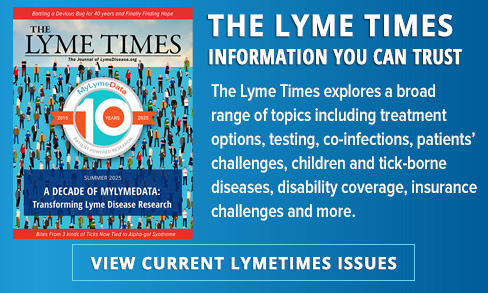PODCAST: How Lyme impacts military personnel and their families

By Fred Diamond
Lyme disease does not discriminate. It affects individuals across all walks of life, including those who dedicate their lives to serving their nation.
For military personnel and their families, Lyme disease is more than a health concern—it’s a crisis that impacts their physical well-being, mental health, and ability to serve.
For active-duty soldiers, Lyme disease can be career-ending.
On this week’s Love, Hope, Lyme podcast, Dr. Angel Davey discusses the unique challenges that Lyme disease poses for soldiers and their loved ones, highlighting the importance of targeted research and awareness initiatives.
Dr. Davey, a civilian, is the Program Manager for the Congressionally Directed Medical Research Programs’ (CDMRP) Tick-Borne Disease Research Program
On February 19, the Center for Lyme Action will hold its annual virtual Fly In, where Lyme advocates meet with their members of Congress to lobby for increased Federal funds for Lyme disease research, treatment, and diagnostics. Some of these funds help support military personnel with Lyme disease.
The Hidden Threat of Lyme Disease in the Military
Between 2006 and 2022, over 7,000 active-duty service members and more than 63,000 family members were diagnosed with tick-borne diseases, with Lyme disease accounting for nearly 80% of these cases. These numbers, derived from the Armed Forces Health Surveillance Division, reveal the startling prevalence of Lyme disease within the military community.
Military personnel are uniquely vulnerable to tick-borne illnesses. Training and deployment often place them in environments with heavy brush, dense vegetation, and high tick populations.
Even with preventive measures such as permethrin-treated uniforms, soldiers remain at risk. Unlike civilian populations, military personnel are frequently exposed to tick-infested areas in diverse climates and geographies around the world, heightening the likelihood of infection.
The Ripple Effect: Impact on Families
When a service member contracts Lyme disease, the consequences extend far beyond the individual. Military families—spouses, children, and other dependents—face their own risks.
These loved ones often live on or near bases where tick populations are prevalent, further increasing their vulnerability. Additionally, families frequently move due to deployments or reassignments, exposing them to various tick habitats.
“The families of service members are at risk for tick bite and potential tick-borne disease, just like anyone in the general population,” Dr. Davey explains.
“But if a family member, such as a parent, a spouse, a child is experiencing challenges that are associated with tick-borne illness, it has the potential to impact the service member’s ability to conduct their job duties.”
For military families, the burden of Lyme disease can be overwhelming. A parent’s chronic illness affects a child’s stability and sense of security. A spouse’s inability to work or care for the family adds financial and emotional strain. This domino effect disrupts the family unit, often making it difficult for service members to focus on their duties, let alone their recovery.
The Challenges of Diagnosis and Treatment
One of the most insidious aspects of Lyme disease is the difficulty of diagnosis. Symptoms mimic those of other conditions, ranging from chronic fatigue to neurological impairments, often leading to misdiagnoses.
In some cases, service members are told they cannot have Lyme disease because “Lyme doesn’t exist here,” a pervasive myth in regions outside the northeastern United States.
For military families stationed in areas with limited Lyme awareness, the road to diagnosis can be long and fraught with frustration. Misdiagnosis or delayed treatment allows the disease to progress, causing long-term health complications that can severely impair the affected individual’s quality of life.
Access to treatment is another major hurdle. Many service members and their families rely on the military healthcare system, which may not always provide the specialized care needed for chronic Lyme disease. Moreover, the costs of prolonged treatments often fall outside the scope of insurance coverage, placing an additional financial strain on families.
Chronic Lyme: A Career-Ender for Many Soldiers
For active-duty soldiers, Lyme disease can be career-ending. Chronic Lyme symptoms—including cognitive dysfunction, debilitating fatigue, and joint pain—make it nearly impossible to meet the physical and mental demands of military service.
For pilots, like retired Colonel Nicole Malachowski, the stakes are even higher. Once diagnosed with Lyme, she and others like her can be grounded indefinitely, unable to continue flying due to the disease’s impact on their health.
Such losses are more than personal—they represent a significant cost to the military. Years of specialized training and experience are lost when a soldier is medically retired due to Lyme disease. This loss of skilled personnel affects unit readiness and overall mission capability, emphasizing the need for better prevention, diagnosis, and treatment strategies.
The Role of the Tick-Borne Disease Research Program
Recognizing the growing impact of tick-borne diseases on service members, Congress established the Tick-Borne Disease Research Program (TBDRP) in 2016 under the Department of Defense’s Congressionally Directed Medical Research Programs (CDMRP).
This initiative began with a $5 million appropriation, largely driven by advocates who highlighted the significant threat Lyme disease poses to military personnel and their families.
TBDRP focuses on four key areas of research:
- Understanding the cellular and molecular mechanisms of tick-borne diseases.
- Developing preventive measures, such as improved repellents and vaccines.
- Advancing diagnostic tools to ensure early and accurate detection.
- Creating effective treatments for both acute and chronic manifestations of the disease.
One of the program’s unique strengths is its integration of patient perspectives. “Patients, survivors, family members, caregivers—those folks are really the why for each CDMRP research program,” Dr. Davey says.
“We make sure to incorporate their lived experience as a part of our two-tier review process so those folks can serve as consumer reviewers, working right alongside scientists and clinicians.”
Innovative Military Resources in Lyme Prevention
The Department of Defense has implemented several initiatives aimed at mitigating the impact of Lyme disease on military personnel. Among them is MilTICK, a tick identification and infection confirmation kit that helps determine health risks associated with tick bites.
MilTICK results provide actionable data for clinicians, enabling timely and appropriate treatment. The program also tracks regional tick-borne disease risks, aiding in prevention efforts across military installations.
Additionally, the MilTICK Surveillance for Understudied Rare and Emerging Pathogens (SURE Path) program, launched in 2024, enhances monitoring of emerging tick-borne disease threats. This initiative reflects the military’s commitment to staying ahead of evolving vector-borne disease challenges, ensuring better protection for soldiers and their families.
The Psychological Toll of Lyme Disease
The mental health impact of Lyme disease cannot be overstated. Chronic illness often leads to depression, anxiety, and feelings of isolation—emotions that are only exacerbated in military families already grappling with the unique stresses of service life. For many soldiers, the inability to perform their duties or return to active service contributes to a sense of loss and diminished self-worth.
Colonel Malachowski has spoken openly about her struggles with chronic Lyme disease, shedding light on the psychological toll it takes. Her story underscores the urgent need for mental health resources tailored to Lyme disease survivors, particularly within the military.
Building Awareness and Support
While significant progress has been made, much work remains to address Lyme disease in the military. Advocacy organizations like the Center for Lyme Action play a crucial role in educating policymakers and securing federal funding for tick-borne disease research. Their efforts have already led to increased awareness on Capitol Hill, paving the way for future advancements.
However, awareness must also extend to the broader military community. Service members and their families need access to accurate information about Lyme disease prevention, symptoms, and treatment options. Routine education and training, coupled with improved access to care, can help mitigate the disease’s impact.
A Call to Action
Lyme disease is not just a civilian issue—it’s a military readiness issue and a family resilience issue. Soldiers and their families deserve the best possible protection against this insidious disease, as well as timely and effective care when prevention falls short. To achieve this, we must:
- Increase funding for research programs like the TBDRP.
- Advocate for comprehensive Lyme disease education within the military healthcare system.
- Ensure that military families have access to specialized care for chronic Lyme disease.
- Support organizations and initiatives that prioritize Lyme disease awareness and treatment.
“The primary thing that I want to let everybody know… is that CDMRP incorporates input from consumers into our program priorities, into our funding strategy, our funding recommendations,” Dr. Davey emphasizes.
“It’s super important to have that perspective to level set everything.”
By addressing these challenges head-on, we can honor the service and sacrifice of our military personnel and their families while building a healthier future for all those affected by Lyme disease.
Click here to listen to all episodes of the Love, Hope, Lyme Podcast or on YouTube.
Opinions, interpretations, conclusions and recommendations are those of the author and are not necessarily endorsed by the Assistant Secretary of Defense for Health Affairs or the Department of Defense.
Fred Diamond is based in Fairfax, Virginia and can be contacted via Facebook. His popular book, “Love, Hope, Lyme: What Family Members, Partners, and Friends Who Love a Chronic Lyme Survivor Need to Know” is available on Amazon. The e-version of the book is always free to Lyme survivors. PM Fred on Facebook or LinkedIn for your copy.





















We invite you to comment on our Facebook page.
Visit LymeDisease.org Facebook Page